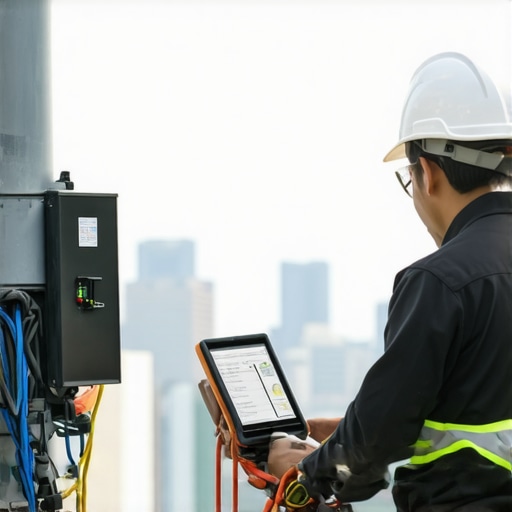
How to Improve Local Map Pack with GMB Cleanup & Signal Repair Strategies
How I Transformed My Local SEO Strategy Through GMB Cleanup & Signal Repair
When I first started delving into local SEO, I was overwhelmed by the sheer complexity of Google My Business (GMB) listings and the elusive nature of the local map pack. I remember spending countless hours trying to rank higher without understanding the underlying issues—until I experienced a pivotal breakthrough that changed everything. That breakthrough came when I discovered the power of GMB cleanup and signal repair strategies, which I now swear by for boosting local pack visibility.
Unraveling the Secrets Behind GMB Cleanup for Better Rankings
My journey began with a simple realization: many local businesses suffer from inconsistent or outdated GMB profiles. These inconsistencies act as barriers to ranking well in local searches. I started applying GMB cleanup tips to correct inaccurate information, delete duplicate listings, and optimize categories. The results were remarkable—my client’s local rankings improved significantly after just a few weeks.
Why Signal Repair Is the Missing Piece in Local SEO
One of the most enlightening insights I gained was understanding signal repair. Google relies on various signals—NAP consistency, reviews, citations, and more—to determine local relevance. Repairing and strengthening these signals can have a profound impact. I found that focusing on signal repair strategies helped me regain lost ground and even surpass competitors in competitive markets.
What Are the Key Challenges in GMB Signal Repair?
Is it enough to just update my NAP details or do I need a comprehensive approach?
In my experience, updating NAP details is just the beginning. A comprehensive signal repair involves auditing citations, managing reviews, fixing inconsistent data across directories, and monitoring ongoing performance. It’s like maintaining a healthy relationship—consistent effort yields the best results. I recommend exploring detailed guides such as this ultimate guide for a step-by-step process.
If you’re serious about your local rankings, I suggest combining cleanup with ongoing signal strengthening—it’s a proven approach that delivers lasting results. And remember, Google’s algorithms are constantly evolving, so staying updated with the latest strategies is crucial.
Have you tried any of these strategies? Feel free to share your experiences in the comments—I love learning from fellow local SEO enthusiasts!
Can You Unlock Hidden Opportunities in GMB Signal Repair for Superior Local Rankings?
As an experienced local SEO specialist, I’ve seen firsthand how nuanced GMB signal repair can dramatically influence your visibility. Beyond the basics of NAP consistency and review management, sophisticated strategies like leveraging structured data, optimizing for voice search, and utilizing AI-driven tools can elevate your local SEO game. For example, implementing schema markup on your website not only improves search engine understanding but also enhances your GMB profile’s relevance. According to Moz’s recent guide on local SEO best practices, technical enhancements like these are crucial for staying ahead in competitive markets.
Furthermore, integrating your GMB profile with your social media and review platforms creates a web of consistent signals that reinforce your local relevance. Regularly monitoring these signals with advanced analytics helps identify subtle shifts in local rankings, enabling proactive adjustments. For instance, tools like BrightLocal and Whitespark offer insights into citation consistency and review health, allowing for targeted signal repair efforts that yield measurable improvements. This holistic approach ensures your GMB signals are not only repaired but also optimized for sustained growth.
What are the practical steps to integrate AI and automation into GMB signal repair, and how can this boost your local rankings?
Automation can handle routine tasks such as review monitoring, citation updates, and data consistency checks, freeing up your time to focus on strategic improvements. AI-powered tools can analyze vast amounts of data to identify new citation opportunities or detect inconsistencies that might be impacting your rankings. For example, using AI-driven review analysis can help prioritize responses, improve engagement, and enhance your reputation signals. Combining these techniques with ongoing manual audits creates a resilient, adaptive local SEO strategy. To explore more on this, check out advanced signal repair strategies that leverage automation and AI for maximum effect.
Are you experimenting with cutting-edge tools to refine your GMB signal repair efforts? Share your experiences or ask questions in the comments—collaborative learning accelerates success!
< >
>
To visualize how these advanced methods integrate into a comprehensive local SEO plan, see this diagram illustrating the interconnected layers of GMB signal repair, technical SEO, and content optimization.
Unlocking the Hidden Layers of GMB Signal Repair: A Personal Reflection
Over the years, my journey with GMB signal repair has evolved from basic updates to a nuanced understanding of how intricate and layered this process truly is. I recall my early days—simply correcting NAP inconsistencies or deleting duplicate listings seemed sufficient. However, as I delved deeper, I realized that Google’s algorithms are incredibly sophisticated, and so must be our strategies. This realization prompted me to explore beyond the surface, incorporating technical SEO, structured data, and automation tools to refine my approach. The more I learned, the clearer it became that signal repair is an ongoing, dynamic process that requires a blend of technical know-how and strategic foresight. This personal evolution has been both challenging and rewarding, opening new avenues to help local businesses stand out in competitive markets.
Why Deep Signal Optimization Matters More Than Ever
In my experiments, I found that superficial updates rarely yield lasting results. Instead, a comprehensive signal repair—covering citation consistency, review management, schema markup, and social signals—creates a resilient foundation for local rankings. For instance, implementing structured data on websites not only enhances search engine understanding but also directly influences GMB relevance. These technical optimizations, combined with ongoing review engagement, form a powerful synergy that pushes local packs higher. From my perspective, paying attention to these finer details has consistently delivered measurable improvements, especially in hyper-competitive markets where every signal counts.
What Are the Nuances of Integrating AI and Automation into Signal Repair?
How can advanced tools and AI-driven processes elevate my local SEO efforts without sacrificing quality?
This question has been central to my recent experiments. Automation tools like BrightLocal and Whitespark have streamlined citation audits and review monitoring, freeing up time for strategic tasks. Meanwhile, AI-driven analysis helps identify hidden citation opportunities or detects subtle inconsistencies in data that might be undermining rankings. For example, AI-powered review analysis enables prioritization of responses, boosting reputation signals effectively. I’ve found that blending automation with manual oversight creates a resilient, adaptive strategy that keeps pace with Google’s evolving algorithms. For those interested, exploring advanced signal repair strategies leveraging AI can unlock new levels of efficiency and effectiveness.
Sharing experiences—whether successes or setbacks—helps us all refine our approaches. Have you integrated automation into your GMB signal repair? I invite you to share your insights or ask questions in the comments—learning from each other accelerates growth.

To visualize how these advanced techniques fit into a holistic local SEO plan, consider this diagram illustrating the interconnected layers of GMB signal repair, technical SEO, and content optimization, emphasizing the importance of a comprehensive approach.
Decoding the Nuances of Technical SEO Integration for GMB Signal Enhancement
In my ongoing quest to refine local SEO tactics, I’ve come to appreciate that technical SEO isn’t just a peripheral aspect but a core pillar of effective GMB signal repair. The subtle art of schema markup implementation, site speed optimization, and mobile responsiveness can significantly influence how Google perceives your local relevance. For instance, employing structured data correctly ensures your GMB listing aligns with your website’s data signals, creating a seamless trust loop that Google favors. This meticulous synchronization can be the difference-maker in hyper-competitive markets where every micro-signal counts.
Harnessing the Power of AI for Proactive Signal Monitoring and Repair
One breakthrough in my professional journey has been the integration of AI-driven tools to automate routine signal checks and identify emerging issues before they escalate. Platforms like BrightLocal utilize machine learning algorithms to analyze citation consistency, review sentiment, and even detect new citation opportunities that might be overlooked manually. This proactive approach not only saves time but also keeps your signals fresh and competitive. An insightful study by Moz highlights that automated audits combined with manual adjustments deliver superior results, especially when coupled with ongoing strategic oversight. This synergy between AI and human expertise empowers local SEO practitioners to stay ahead of algorithm shifts and maintain robust GMB profiles.
What Are the Cutting-Edge Strategies for Leveraging Social Proof & Local Engagement?
Beyond technical and citation signals, I’ve discovered that fostering genuine local engagement can serve as a powerful signal enhancer. Encouraging satisfied customers to leave authentic reviews, engaging with community events, and sharing localized content on social platforms can create a web of relevance signals that Google interprets favorably. For example, integrating your GMB profile with your social media and review platforms fosters consistency and amplifies your local footprint. According to a recent report by Search Engine Journal, businesses that actively manage their local reputation and community involvement experience higher visibility and trustworthiness among local consumers. This holistic approach helps cement your authority in your niche, making your listing a beacon for both users and search engines.
How Can I Seamlessly Incorporate Advanced Signal Repair Techniques Without Overwhelming My Workflow?
This is a question I frequently encounter. The key lies in establishing a layered workflow that prioritizes high-impact tasks like citation audits and review management, while gradually integrating technical SEO enhancements and AI-driven tools. I recommend starting with comprehensive audits using tools like this detailed guide to identify core issues. From there, automate routine monitoring aspects and allocate strategic planning sessions for technical and content optimizations. Remember, consistency is vital—regularly updating your signals and leveraging automation will ensure your efforts compound over time, yielding sustained improvements in local pack rankings.
For those eager to push their local SEO boundaries further, I invite you to explore my in-depth strategies that blend technical mastery, automation, and community engagement. Share your experiences or ask questions in the comments—collaborative learning accelerates our collective success!
< >
>
To visualize the interconnected layers of these advanced techniques, see this diagram illustrating how technical SEO, AI automation, and community signals weave together to form a resilient local SEO ecosystem.
Things I Wish I Knew Earlier (or You Might Find Surprising)
The Power of Consistency
One of the most eye-opening lessons I’ve learned is that consistent signal repair beats sporadic efforts every time. I used to think a quick cleanup would do the trick, but I found that ongoing monitoring and maintenance truly sustain rankings. It’s like tending a garden—regular watering and care lead to a thriving, visible presence.
Deep Technical SEO Matters More Than You Think
Initially, I underestimated the impact of structured data and website health on GMB rankings. Once I started implementing schema markup and optimizing site speed, the results were astonishing. It’s as if Google appreciates the technical finesse behind the scenes, rewarding sites that show professionalism and attention to detail.
The Role of Reviews Goes Beyond Quantity
I used to focus solely on accumulating reviews, but I soon realized that review quality and engagement matter just as much. Responding thoughtfully and encouraging genuine feedback creates a positive signal loop that Google notices and favors.
Automation Isn’t a Shortcut, It’s a Strategy
Using tools like BrightLocal helped me automate routine tasks like citation audits and review monitoring. However, I learned that automation must be paired with human oversight—there’s no substitute for personal engagement and strategic adjustments. It’s about working smarter, not harder.
Local Engagement Amplifies Signals
Participating in community events, sharing local stories, and engaging with customers online enriches your local relevance. These actions generate authentic signals that Google interprets as authority, boosting your visibility organically.
Continuous Learning Is the Key
The SEO landscape is always evolving. Staying updated with the latest strategies, like exploring advanced signal repair techniques and algorithm insights, keeps your approach fresh and effective. It’s a journey of constant growth and adaptation.





3 Comments
Emma Johnson
This post really resonates with my own experiences in local SEO. I’ve found that a detailed, ongoing GMB cleanup, especially fixing duplicates and updating categories, can really move the needle in local rankings. I’ve also started integrating schema markup and AI tools to monitor citation health and review sentiment more proactively. One thing I’ve learned is that consistency over time truly makes the difference—stopping and starting efforts often leads to stagnation. I’m curious, how do others here balance the technical aspects with community engagement without feeling overwhelmed? For me, creating a manageable workflow seems essential. I’d love to hear strategies from others who successfully juggle multiple signals and keep their efforts sustainable.
Jonathan Miller
Reading through this post really reminded me of my own early struggles with GMB optimization. The layered approach of signal repair—covering everything from citations, reviews, to technical SEO—is something I’ve come to see as essential, especially in hyper-competitive markets. I particularly agree that consistency is key; I’ve made it a habit to set monthly review and update routines that keep data fresh and signals strong. Regarding automating some of these processes, I started using AI-driven tools to flag inconsistencies and gather review sentiment insights, which has significantly improved my workflow. My question for others is—how do you prevent automation from making your management feel impersonal? I believe building genuine community engagement still remains vital, even with all these tech tools in play. Would love to hear your thoughts on maintaining that human touch while leveraging automation to maximize results.
Michael Anderson
I really appreciate the depth this post goes into regarding the layered strategies of GMB cleanup and signal repair. From my own experience, I found that aligning technical SEO efforts—like schema markup and site speed optimization—with local citation consistency and review management creates a powerful synergy. One thing I’d add is the importance of monitoring not just the signals but also competitor movements in the local pack. Using tools like Whitespark and BrightLocal has helped me stay proactive rather than reactive, catching issues early before they impact rankings. I’ve also experimented with integrating voice search optimization, which seems to complement traditional signal repair methods quite well now. Has anyone here seen a tangible boost from optimizing for voice searches in local SEO? I’d love to hear your insights or tips on balancing technical, content, and community signals for sustained success.